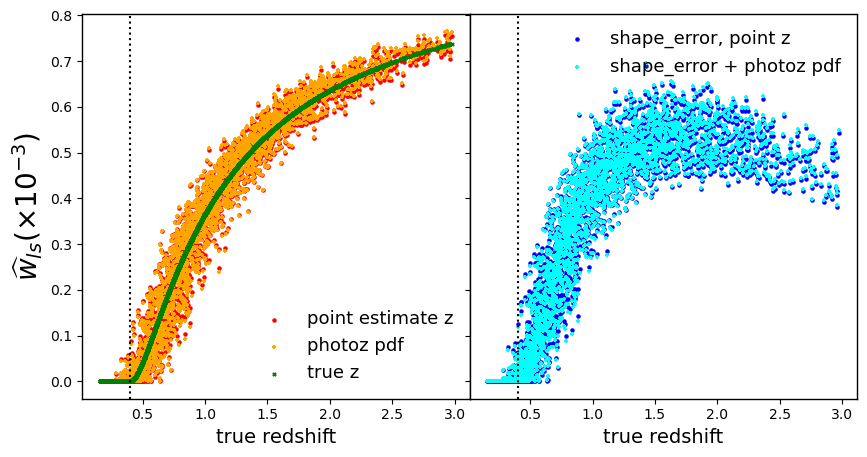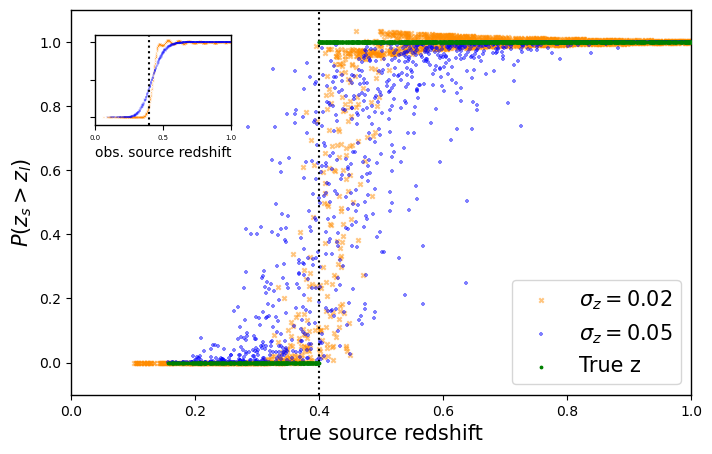Weak lensing weights
Weak lensing weights to compute the \(\Delta\Sigma\) profile
The excess surface mass density profile computed from the data is computed from a weighted average
where the sum runs over all lens-background source pairs, \(\epsilon_+^{l,s}\) is the tangential ellipticity, \(\Sigma_{\rm crit}(z_s, z_l)\) is the critical surface density, and where the weights
Where \(p(z)\) is the photometric redshift ditribution. These weights correspond to the maximum likelihood estimator of \(\Delta\Sigma\) (e.g., Shirasaki & Takada 2018).
Identifying background galaxies can be made by considering the individual probability to be in the background of the cluster i.e.
to be higher than a given threshold.
In this notebook, we show the clmm functionalities developed to
compute: - those weights under a variety of configuration (true
redhsifts or photoz, shape noise or not, ideal galaxy shapes or not). -
the background probability \(P(z > z_l)\) for each galaxy
%load_ext autoreload
%autoreload 2
import sys
import os
import numpy as np
import matplotlib.pyplot as plt
from astropy.table import Table
import scipy
import copy
import clmm
from clmm import Cosmology
from clmm import GalaxyCluster
from clmm.dataops import compute_galaxy_weights, compute_background_probability
from clmm.support import mock_data as mock
from clmm.theory import compute_critical_surface_density_eff
clmm.__version__
'1.12.0'
np.random.seed(11)
cosmo = Cosmology(H0=71.0, Omega_dm0=0.265 - 0.0448, Omega_b0=0.0448, Omega_k0=0.0)
cluster_z = 0.4
cluster_m = 1.0e14
cluster_c = 4
cluster_ra = 0.0
cluster_dec = 0.0
noisy_data_z = mock.generate_galaxy_catalog(
cluster_m,
cluster_z,
cluster_c,
cosmo,
cluster_ra=cluster_ra,
cluster_dec=cluster_dec,
delta_so=200,
massdef="critical",
halo_profile_model="nfw",
zsrc="chang13",
zsrc_min=0.15,
zsrc_max=3.0,
photoz_sigma_unscaled=0.05,
shapenoise=0.05,
mean_e_err=0.1,
field_size=10.0,
ngals=3000,
)
z_gal = noisy_data_z["ztrue"]
# add redshift dependency on shape measurement error
noisy_data_z["e_err"] = noisy_data_z["e_err"] * (1 + 0.4 * noisy_data_z["ztrue"])
cluster = GalaxyCluster("mock_cluster", cluster_ra, cluster_dec, cluster_z, noisy_data_z)
/global/homes/a/aguena/.local/perlmutter/python-3.11/lib/python3.11/site-packages/clmm-1.12.0-py3.11.egg/clmm/theory/parent_class.py:768: UserWarning:
Some source redshifts are lower than the cluster redshift.
Shear = 0 for those galaxies.
/global/homes/a/aguena/.local/perlmutter/python-3.11/lib/python3.11/site-packages/clmm-1.12.0-py3.11.egg/clmm/theory/parent_class.py:852: UserWarning:
Some source redshifts are lower than the cluster redshift.
Convergence = 0 for those galaxies.
Compute the WL weights
redshift point estimate + no shape error
Using the functional interface
First, we need to compute \(\Sigma_{\rm crit}\). Here, we use the
true source redshifts stored in z_gal
sigma_c = cosmo.eval_sigma_crit(cluster_z, z_gal)
/global/homes/a/aguena/.local/perlmutter/python-3.11/lib/python3.11/site-packages/clmm-1.12.0-py3.11.egg/clmm/cosmology/parent_class.py:110: UserWarning:
Some source redshifts are lower than the cluster redshift.
Sigma_crit = np.inf for those galaxies.
w_ls_true = compute_galaxy_weights(
sigma_c=sigma_c,
is_deltasigma=True,
use_shape_noise=False,
)
As a method of the GalaxyCluster object
As a method of the GalaxyCluster object, compute_galaxy_weights
uses the content of the z column of the object’s galcat table as
the source redshift point estimates. Given that mock data was generated
with a photoz error, this point estimate is different from the true
redshift used in the cell above.
w_ls_point = cluster.compute_galaxy_weights(
use_pdz=False, weight_name="w_ls_point", cosmo=cosmo, is_deltasigma=True, add=True
)
/global/homes/a/aguena/.local/perlmutter/python-3.11/lib/python3.11/site-packages/clmm-1.12.0-py3.11.egg/clmm/cosmology/parent_class.py:110: UserWarning:
Some source redshifts are lower than the cluster redshift.
Sigma_crit = np.inf for those galaxies.
photoz + no shape errors
When considering the photo-z distribution, we can compute the weight based on an effective critical surface density:
where
Using the functional interface
First, we need to compute \(\Sigma_{\rm crit}^{\rm eff}\). Here, we
use the true source redshifts stored in z_gal
sigma_c_eff = compute_critical_surface_density_eff(
cosmo=cosmo,
z_cluster=cluster_z,
pzbins=noisy_data_z.pzpdf_info["zbins"],
pzpdf=noisy_data_z["pzpdf"],
)
/global/homes/a/aguena/.local/perlmutter/python-3.11/lib/python3.11/site-packages/clmm-1.12.0-py3.11.egg/clmm/cosmology/parent_class.py:110: UserWarning:
Some source redshifts are lower than the cluster redshift.
Sigma_crit = np.inf for those galaxies.
w_ls_photoz = compute_galaxy_weights(
sigma_c=sigma_c_eff,
is_deltasigma=True,
use_shape_noise=False,
)
As a method of the GalaxyCluster object
When used as a method of the GalaxyCluster object, with
use_pdz=True, compute_galaxy_weights uses the content of the
pzpdf and pzbins columns of the galcat table. It will return
an error if those do not exist.
w_ls_photoz = cluster.compute_galaxy_weights(
use_pdz=True, weight_name="w_ls_photoz", cosmo=cosmo, is_deltasigma=True, add=True
)
/global/homes/a/aguena/.local/perlmutter/python-3.11/lib/python3.11/site-packages/clmm-1.12.0-py3.11.egg/clmm/cosmology/parent_class.py:110: UserWarning:
Some source redshifts are lower than the cluster redshift.
Sigma_crit = np.inf for those galaxies.
redshift point estimate + shape error
w_ls_shape = cluster.compute_galaxy_weights(
use_pdz=False,
use_shape_noise=True,
shape_component1="e1",
shape_component2="e2",
use_shape_error=True,
shape_component1_err="e_err",
shape_component2_err="e_err",
weight_name="w_ls_shape",
cosmo=cosmo,
is_deltasigma=True,
add=True,
)
photoz + shape error
w_ls_photoz_shape = cluster.compute_galaxy_weights(
use_pdz=True,
use_shape_noise=True,
shape_component1="e1",
shape_component2="e2",
use_shape_error=True,
shape_component1_err="e_err",
shape_component2_err="e_err",
weight_name="w_ls_photoz_shape",
cosmo=cosmo,
is_deltasigma=True,
add=True,
)
With add=True, the weights have been added as new columns in the
cl.galcat Table. A new sigma_c column is also automatically
added.
cluster.galcat.colnames
['ra',
'dec',
'e1',
'e2',
'e_err',
'z',
'ztrue',
'pzpdf',
'id',
'sigma_c',
'w_ls_point',
'sigma_c_eff',
'w_ls_photoz',
'w_ls_shape',
'w_ls_photoz_shape']
\(\Sigma_{\rm crit}\) metadata
As seen above, the weights are computed either using the standard definition of \(\Sigma_{\rm crit}^{\rm std}\), using point estimate redshift, or the effective definition based on the inverse \(\Sigma_c^{\rm eff}\) averaged over the redshift PDF \(p(z)\):
To keep track of what definition of \(\Sigma_{\rm crit}\) was used,
standard or effective the user may look into the galcat
metadata
print(
"For cluster w_ls_point column :",
cluster.galcat.meta["w_ls_point_sigmac_type"],
)
print(
"For cluster w_ls_photoz column :",
cluster.galcat.meta["w_ls_photoz_sigmac_type"],
)
print(
"For cluster w_ls_shape column :",
cluster.galcat.meta["w_ls_shape_sigmac_type"],
)
print(
"For cluster w_ls_photoz_shape column :",
cluster.galcat.meta["w_ls_photoz_shape_sigmac_type"],
)
For cluster w_ls_point column : standard
For cluster w_ls_photoz column : effective
For cluster w_ls_shape column : standard
For cluster w_ls_photoz_shape column : effective
Vizualizing the results
The figure below shows the normalized weight per galaxy \(\widehat{w}_{ls} = \frac{w_{ls}}{\sum _{s = 1}^N w_{ls}}\).
plt.rcParams["axes.linewidth"] = 1
fig, ax = plt.subplots(1, 2, figsize=(10, 5), sharey=True)
fig.subplots_adjust(wspace=0, hspace=0)
ax[0].tick_params(axis="both", which="major", labelsize=10)
ax[1].tick_params(axis="both", which="major", labelsize=10)
ax[0].axvline(cluster_z, color="black", linestyle=":")
ax[1].axvline(cluster_z, color="black", linestyle=":")
ax[0].scatter(
z_gal,
1e3 * cluster.galcat["w_ls_point"] / cluster.galcat["w_ls_point"].sum(),
c="r",
label="point estimate z",
s=5,
)
ax[0].scatter(
z_gal,
1e3 * cluster.galcat["w_ls_photoz"] / cluster.galcat["w_ls_photoz"].sum(),
c="orange",
label="photoz pdf",
marker="+",
s=5,
)
ax[0].scatter(z_gal, 1e3 * w_ls_true / w_ls_true.sum(), c="g", label="true z", marker="x", s=5)
ax[1].scatter(
z_gal,
1e3 * cluster.galcat["w_ls_shape"] / cluster.galcat["w_ls_shape"].sum(),
c="blue",
label=r"shape_error, point z",
s=5,
)
ax[1].scatter(
z_gal,
1e3 * cluster.galcat["w_ls_photoz_shape"] / cluster.galcat["w_ls_photoz_shape"].sum(),
c="cyan",
label="shape_error + photoz pdf",
s=5,
marker="+",
)
ax[0].legend(frameon=False, fontsize=13)
ax[1].legend(frameon=False, fontsize=13)
ax[0].set_ylabel(r"$\widehat{w}_{ls} (\times 10^{-3})$", fontsize=20)
ax[0].set_xlabel("true redshift", fontsize=14)
ax[1].set_xlabel("true redshift", fontsize=14)
Text(0.5, 0, 'true redshift')

The galaxy weights increase with the true galaxy redshift (left panel, red dots), i.e. weights take account that galaxies far from the cluster are more sheared than closer ones.
Using true redshift (left panel, green dots), weights for foreground galaxies are 0.
Adding photoz, either point estimate or including p(z) (left panel, red and orange dots):
weights are scattered around the true redshift weigthts (when photoz’s are not biased)
some foreground galaxies (with true redshift < \(z_{\rm cluster}\)) have non-zero weights
here the point estimate and p(z) results are very close because
mock_datagenerates photoz a gaussian p(z) with the point estimate at the mean. Reality will be more complex and the orange and red points may differ more.
Adding shape error with redshift dependency \(\sigma(z) = \sigma_0(1 + \alpha z)\) (right panel, blus dots), high redshift galaxies with measured shapes have smaller weights than considering true shapes (comparing to left panel, red dots).
when combining photoz + shape error, both effects can be seen on galaxy weights (right panel, cyan dots).
Background probability
The probability for a galaxy with photometric redshift of being in the background of the cluster is given by
# Generate new GC object with smaller photoz dispersion for comparison with cl0.
noisy_data_z_2 = mock.generate_galaxy_catalog(
1e14,
cluster_z,
4,
cosmo,
delta_so=200,
massdef="critical",
halo_profile_model="nfw",
zsrc="chang13",
zsrc_min=0.1,
zsrc_max=3.0,
photoz_sigma_unscaled=0.02,
shapenoise=0.05,
mean_e_err=0.1,
field_size=10.0,
ngals=3000,
)
cluster_new = clmm.GalaxyCluster("mock_cluster", 0, 0, cluster_z, noisy_data_z_2)
/global/homes/a/aguena/.local/perlmutter/python-3.11/lib/python3.11/site-packages/clmm-1.12.0-py3.11.egg/clmm/theory/parent_class.py:768: UserWarning:
Some source redshifts are lower than the cluster redshift.
Shear = 0 for those galaxies.
/global/homes/a/aguena/.local/perlmutter/python-3.11/lib/python3.11/site-packages/clmm-1.12.0-py3.11.egg/clmm/theory/parent_class.py:852: UserWarning:
Some source redshifts are lower than the cluster redshift.
Convergence = 0 for those galaxies.
p_background_true = compute_background_probability(cluster_z, z_gal) # based on cl0 generation
p_background_photoz_1 = cluster.compute_background_probability(
use_pdz=True, p_background_name="p_background_photoz_1", add=True
)
p_background_photoz_2 = cluster_new.compute_background_probability(
use_pdz=True, p_background_name="p_background_photoz_2", add=True
)
# plt.rcParams['axes.linewidth'] = 1
fig = plt.figure(figsize=(8, 5))
plt.tick_params(axis="both", which="major", labelsize=10)
plt.scatter(
cluster_new.galcat["ztrue"],
p_background_photoz_2,
c="darkorange",
label=r"$\sigma_z = 0.02$",
marker="x",
s=10,
alpha=0.5,
)
plt.scatter(
cluster.galcat["ztrue"],
p_background_photoz_1,
c="blue",
label=r"$\sigma_z = 0.05$",
marker="+",
s=10,
alpha=0.5,
)
plt.scatter(z_gal, p_background_true, c="green", s=3, zorder=110, label="True z")
plt.vlines(cluster_z, -0.1, 1.1, color="k", linestyle=":")
plt.xlim([0.0, 1])
plt.ylim([-0.1, 1.1])
plt.xlabel("true source redshift", fontsize=15)
plt.ylabel(r"$P(z_s > z_l)$", fontsize=15)
plt.legend(frameon=True, fontsize=15, loc=4)
ax2 = fig.add_axes([0.155, 0.65, 0.17, 0.18])
ax2.scatter(
cluster_new.galcat["z"],
p_background_photoz_2,
c="darkorange",
label=r"$\sigma_z = 0.02$",
marker="x",
s=1,
alpha=0.5,
lw=0.1,
)
ax2.scatter(
cluster.galcat["z"],
p_background_photoz_1,
c="blue",
label=r"$\sigma_z = 0.05$",
marker="+",
s=1,
alpha=0.5,
lw=0.1,
)
for item in (
ax2.title,
ax2.xaxis.label,
ax2.yaxis.label,
*ax2.get_xticklabels(),
*ax2.get_yticklabels(),
):
item.set_fontsize(5)
ax2.set_yticklabels([])
ax2.vlines(cluster_z, -0.1, 1.1, color="k", linestyle=":")
ax2.set_xlim([0.0, 1])
ax2.set_ylim([-0.1, 1.1])
ax2.set_xlabel("obs. source redshift", fontsize=10)
Text(0.5, 0, 'obs. source redshift')

The figure above shows the background probability \(P(z > z_l)\) for each galaxy. - When using true redshift (green), the background probability is a Heavyside function centered on \(z_s\), i.e. \(p(z) = \delta^D(z-z_s)\). - When using photometric redshift (blue and orange dots), galaxies on the foreground of the cluster have non-zero probability to be in the background. Idem, for close galaxies in the background, the probability in being in the foreground is non-zero. - These weights represent the fraction of the galaxy PDF that is located behind the cluster and is mapped to the observed redshift as it can be seen on the top left panel. The scatter in the main panel comes from the scatter between true and observed redshifts.